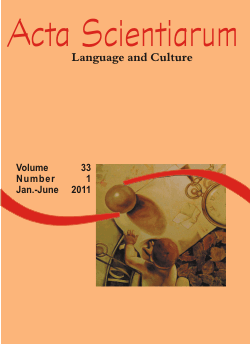<b>On Pasolini’s <em>Edipo Re</em>: an overview with a focus on two neglected details. Unconscious, will, chance and destiny</b> - doi: 10.4025/actascilangcult.v33i1.8281
Abstract
The present study aims at re-analyzing two specific aspects of Pasolini’s cinematic staging of Sophocles’ Oedipus Rex that seem to have received little attention. The first aspect concerns the subtle usage of body language, such as “covering the eyes, crying, gaze-interactions, starring someone or something in silence”. They are peculiar details that betray, so to speak, the presence both of typically Freudian concepts (such as, “the removing of disturbing truth to the unconscious, and the unconscious awareness of the truth”), and some typically Sophoclean ideas (such as, “resignation” to what is inescapable and acceptance of it). This analysis is thus conducted within the perspective of the complex interrelation between Sophocles’ text and the Freudian interpretation that Pasolini has applied to it. The second aspect, while analyzing Pasolini’s self-commentary on some portions of the film, pertains to an enigmatic statement of Pasolini himself which seems to have been mostly dismissed. Pasolini’s enigmatic statement touches on issues essential both to Sophocles’ tragedy and its modern reception; it indeed involves the everlasting discussion on the play about the dialectical tension among “will”, “chance” and “destiny” in Oedipus’ story and in human condition, as exemplified by the individual case of Pasolini.Downloads
DECLARATION OF ORIGINALITY AND COPYRIGHTS
I Declare that current article is original and has not been submitted for publication, in part or in whole, to any other national or international journal.
The copyrights belong exclusively to the authors. Published content is licensed under Creative Commons Attribution 4.0 (CC BY 4.0) guidelines, which allows sharing (copy and distribution of the material in any medium or format) and adaptation (remix, transform, and build upon the material) for any purpose, even commercially, under the terms of attribution.
Read this link for further information on how to use CC BY 4.0 properly.




















6.png)









